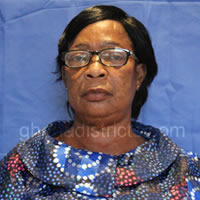Location and Size
Builsa South District is one of the eight Districts in the Upper East Region of Ghana. It lies between longitudes 10 05’West and 10 35’ West and latitudes 100 20’ North and 100 50’ North. It is bounded on the North and East by the Kassena-Nankana District on the west by the Sissala District and on the South by the West Mampruisi District and part of Kassena-Nankana District. The District covers an area of 2,220 km2 and constitutes 25.1% of the total land area of the Upper East Region.
Relief and Drainage
Relief
The topography of the area is undulating and slopes ranging from 200 metres to 300 metres are found in the Northern part of the District particularly around Bachonsa and Chuchuliga zones. In the valleys of Sissili, Kulpawn, Besibeli, Tono, Asibelika and the Azimzim, the slopes are gentler and range from 150 metres to 200 metres. Inselbergs and other granitic outcrops occasionally break the monotony of the near flat surfaces. In general the low-lying nature of the land makes greater part of it liable to flooding in years of copious rains.
Drainage
Like most parts of Northern Ghana, a significant portion of the District falls within the Volta basin and is heavily dissected by a number of important tributaries of the White Volta such as the Sissili, Kulpawn, Tono, Asebelika, Belipieni, etc, giving a very high drainage density. Most of these streams are however seasonal and dry up during the extended dry season with an adverse effect on the supply of water for both agricultural and domestic use.
Besides the high drainage density coupled with the low-lying terrain reduces the level of accessibility in the District. Between July and October in particular most rivers and streams overflow their banks, a number of roads, tracks and foot paths are flooded and settlements cut off from the centre.
Climate
Temperature
The District has mean monthly temperatures ranging between 21.90 C and 34.10 C. The highest temperatures are recorded in March and this can rise to 450 C, whereas the lowest temperatures are recorded in January. The dry season is characterised by dry harmattan winds and wide diurnal temperature ranges.
Rainfall
There is only one rainy season, which builds up gradually from little rains in April to a maximum in August-September, and then declines sharply coming to a complete halt in mid-October when the dry season sets in. Rainfalls are very torrential and range between 85mm and 1150mm p.a. with irregular dry spells occurring in June or July.
Vegetation and Land uses
The vegetation of the District is characterised by savannah woodland and consists mostly of deciduous, widely spaced fire and drought resistant, trees of varying sizes and density with dispersed perennial grasses and associated herbs. Through the activities of man, the woodland savannah has been reduced to open parkland where only trees of economic value like baobab, acacia, sheanut and the dawadawda have been retained with time.
These trees satisfy domestic requirements for fuel wood and timber for local housing construction, cattle kraals, vegetable garden fences and materials for handicraft. On the whole there are about sixteen (14) different land uses derived from the main natural savannah vegetation. These are:
- Mixed arable cropping grass and herb with or without savanna trees.
- Mixed arable cropping closed savanna woodland
- Mixed arable cropping open savanna woodland.
- Mixed arable cropping, widely open savanna woodland.
- Closed forest plantation
- Reserved closed savanna woodland
- Open-access savanna woodland
- Reserved open savanna woodland
- Open-access open savanna woodland with/without scattered farms/grazing
- Open-access grassland with/without scattered farms.
- Riverine vegetation with/without farms
- Forests
- Cloud/Haze covered vegetation
- Reservoir (dam) sites
In the dry season, annual bush fires decimate the grasses and shrubs and as a result pastures for livestock are largely destroyed. These bush fires also ravage the forest reserves in the District and render them hardly distinguishable from the surrounding vegetation.
Geology and Minerals
Geology
The main rock types underlying soils of the District are Granitic formations, Birimian rocks, Voltaian shale and Alluvia material or deposits.
- Granitic Rocks including hornblende granite constitute over 70% of the geological formations of the District and cover about 153, 295 hectares of the area.
They stretch across the northern section of the District from Chuchuliga to Doninga, covering greater part of Sandema and Siniensi Zones. They extend southwards to Wiaga, parts of Gbedema, Uwasi and Southern Fumbisi. Few iron as well as concretions of manganese dioxide and calcium carbonate may be found in these rock deposits.
- Birimian rock formations: These cover approximately 11,905 hectares or a little over 5% of the sub-soil and are found extensively in eastern and southern parts of Kadema. They are also localized outside Fumbisi south. The Birimian formations have abundant green stone brash aggregates with some quartz stones in a matrix of brown to reddish brown silty clay.
- Voltaian Shales: The Voltaian Shales are relatively minor in extent and cover 10,950 hectares or about 5% of the District. They are in the South Eastern and Southern parts of the District, mostly around Uwasi and Gbedembilisi area and in the flood plains of the White Volta.
- Alluvial Deposits: These constitute the second largest group of geological formations in the District and are made up of recent and old alluvia sand stones as well as very old river terraces. They cover some 28,970 hectares or 19% of the land area and are found mostly in the terraces of the White Volta and its tributaries, namely Sissili, Kulpawn and Kandembeli. They cover parts of Wiesi, Gbedembilisi and south of Uwasi.
Soils
As noted from above, the soils of Builsa District are developed from five different geological formations namely Granite, Birimian rocks, Voltaian shale, Recent and Old Alluvium of mixed origin and Very Old River Terraces. Out of these, the dominant soil groups in the District are of granite origin and they cover over 70% (approximately 153,300ha) of the District’s land area. They form the predominant soils in the northern half of the District and more than half of the southern section.
Most of these soils are Gravelly and concretionary, except for the lower slope and valley bottom soils, which are generally free of gravel and concretions. Majority of the soils can be used for agriculture except the Wenchi and Chuchuliga series, which are considered as non-agricultural soils. This is because of the presence of iron pan boulders, occurrence of iron pan at shallow depths, rock outcrops and little profile development in some of these soils. These non-agricultural soils cover more than 2.0% of the District.
Date Created : 12/5/2017 2:13:56 AM





 facebook
facebook twitter
twitter Youtube
Youtube TOLL FREE 0800 430 430
TOLL FREE 0800 430 430 +233 593 831 280
+233 593 831 280 GPS: GE-231-4383
GPS: GE-231-4383 info@ghanadistricts.com
info@ghanadistricts.com Box GP1044, Accra, Ghana
Box GP1044, Accra, Ghana